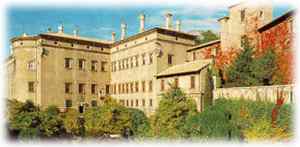Castello del Buonconsiglio
 The Castle used
to be the residence of the bishop princes. It is surrounded by walls fortified with low
turrets. It is made up of various parts: to the north, the cylindrical tower "torre
Grande" stands over the embattled "Castelvecchio". Originally built in the
thirteenth century and altered in 1475 according to the gothic-venetian style, the edifice
surrounds a picturesque court with frescoed portico, decorated in part by Fogliolino
(1535). The so-called "giunta Albertina" situated at the centre was built in the
sixteenth century and joins the northern buildings to the "Magno Palazzo" to the
south. This last was commissioned in 1530 (Renaissance period) by the bishop prince
Bernardo Clesio, and is characterized by a wide, splendidly frescoed portico overlooking
the "cortile dei Leoni", splendidly frescoed by Girolamo Romanino in 1531-32.
The castle houses the CASTELLO DEL BUONCONSIGLIO MUSEUM (open 9-12 am and 2-5 pm from
October to March; until 5.30 from April to September; closed on Mondays), Trentino
headquarters of the "Museo proviciale d'Arte" (Art museum of the province) which
also has sections in the castles Beseno, Stenico and Thun. The museum is made up of three
sections: ancient, mediaeval and modern. From the entrance, across the garden and to the
right are located the cells of the patriots Damiano Chiesa, Cesare Battisti and Fabio
Filzi, executed in the trench behind the building in 1916. The museum also contains
archeological findings, works of art (coins, manuscripts, sacred objects, paintings), and
ethnographic material, displayed in various rooms of the Magno Palazzo and Castelvecchio.
Many of these have carved wooden ceilings, frescoed by Dosso Dossi, Romanino and
Fogliolino (XVI century). Of particular interest are the frescoes which picture the twelve
months of the year in Torre dell'Aquila, painted by an anonymous fourteenth-century artist
in the international gothic style. For securoty measures, visits are restricted to groups
of max. twenty people, escorted by museum personnel). A restored building houses the civic
museum of the Risorgimento and fight for freedom (opening hours; same as Castle museum),
containing mainly relics and mementoes of the irredentist movement of the first world war
and of the Resistance.
The Castle used
to be the residence of the bishop princes. It is surrounded by walls fortified with low
turrets. It is made up of various parts: to the north, the cylindrical tower "torre
Grande" stands over the embattled "Castelvecchio". Originally built in the
thirteenth century and altered in 1475 according to the gothic-venetian style, the edifice
surrounds a picturesque court with frescoed portico, decorated in part by Fogliolino
(1535). The so-called "giunta Albertina" situated at the centre was built in the
sixteenth century and joins the northern buildings to the "Magno Palazzo" to the
south. This last was commissioned in 1530 (Renaissance period) by the bishop prince
Bernardo Clesio, and is characterized by a wide, splendidly frescoed portico overlooking
the "cortile dei Leoni", splendidly frescoed by Girolamo Romanino in 1531-32.
The castle houses the CASTELLO DEL BUONCONSIGLIO MUSEUM (open 9-12 am and 2-5 pm from
October to March; until 5.30 from April to September; closed on Mondays), Trentino
headquarters of the "Museo proviciale d'Arte" (Art museum of the province) which
also has sections in the castles Beseno, Stenico and Thun. The museum is made up of three
sections: ancient, mediaeval and modern. From the entrance, across the garden and to the
right are located the cells of the patriots Damiano Chiesa, Cesare Battisti and Fabio
Filzi, executed in the trench behind the building in 1916. The museum also contains
archeological findings, works of art (coins, manuscripts, sacred objects, paintings), and
ethnographic material, displayed in various rooms of the Magno Palazzo and Castelvecchio.
Many of these have carved wooden ceilings, frescoed by Dosso Dossi, Romanino and
Fogliolino (XVI century). Of particular interest are the frescoes which picture the twelve
months of the year in Torre dell'Aquila, painted by an anonymous fourteenth-century artist
in the international gothic style. For securoty measures, visits are restricted to groups
of max. twenty people, escorted by museum personnel). A restored building houses the civic
museum of the Risorgimento and fight for freedom (opening hours; same as Castle museum),
containing mainly relics and mementoes of the irredentist movement of the first world war
and of the Resistance.